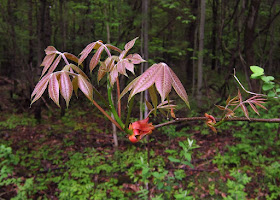The Red Maple buds (Acer rubrum) are especially vivid, leafing out in gorgeous sherbet hues.
This Red Maple branch looks as if a flock of colorful birds has landed on it.
Backlit by the sun, these maple leaves glow like stained glass.
I always wax ecstatic about the big velvety buds of Striped Maple (Acer pensylvanicum), and I'm equally delighted by what happens when those buds open to release two big green leaves. Then they look like green-winged, pink-velvet-gowned fairies wafting through the woods.
Talk about big fat buds! I think the apricot satin buds of Shagbark Hickory (Carya ovata) take the prize for enormousness before they erupt in an explosion of shiny-red pinnate leaves.
The male flowers of Norway Maple (Acer platanoides) look like tiny bright-yellow bouquets held in dark-red vases.
These newborn, deeply grooved leaves of Alternate-leaved Dogwood (Cornus alternifolia) have an elegant, subtle beauty all their own.
The fire-colored baby leaves of Panicled Dogwood (Cornus racemosa) always make me think of flickering flames.
When the stork-billed buds of Nannyberry (Viburnum lentago) open to release the brightly colored leaves, they also reveal the infant flower cluster, still tightly closed, nestling down in the center.
The flower cluster of Maple-leaved Viburnum (Viburnum acerifolia) is also tightly closed as yet, but its shiny quilted leaves have opened into a beautiful study in symmetry.
The leaf and flower buds of Hobblebush (Viburnum lantanoides) became fully formed way last fall and made it through the winter protected only by a thin layer of brown flocking. So they were ready to burst out of their confines as soon as the days grew warmer.
The flower buds of American Bladdernut (Staphylea trifolia) resemble a couple of handfuls of green peas. If hands were green, of course.
The staminate flowers of Northern Prickly Ash (Zanthoxylum americanum) look as spiky as tiny porcupines climbing the twigs. And those twigs are certainly prickly. This is not the most beautiful shrub we have, but it's the only citrus native to our northern climes, and as such it is the only possible food for the larvae of the Giant Swallowtail Butterfly. So please tolerate it if you find it on your land.
We've seen the copper-penny-bright pointed buds of American Beech (Fagus grandifolia) all winter, but now those sharp spindle-shaped buds have opened to release finely pleated leaves made downy with baby-fine hairs. I always want to pet them, they look so kitten-soft.
Talk about soft and furry! How about these baby oak leaves? And a pretty pink color, to boot!
If you're walking a sandy, open spot, look down to discover the burgundy-red miniature starbursts of baby Wild Lupine leaves (Lupinus perennis), covered with downy fur. That down keeps the leaves from wetting, so morning dew has collected in the center to form these diamond drops.
Update: I posted a few of these photos on Facebook, and one of my Facebook friends commented with this beautiful commentary on spring buds by Hal Boland, a naturalist and staff writer for the NY Times who chronicled the seasons in memorable prose. He died in 1978. I share this passage here.
The New Leaves
The early flowers are bright in meadow and woodland, but the overwhelming beauty as May begins is in the new leaves on trees and bushes. We take leaves for granted; but when they are seen individually and fresh from the bud they are in no sense commonplace.
Is there a more beautiful sight than a Pin Oak fringed with the pink of freshly opening leaves?
Or a sugar maple when its blossoms have begun to fade, its keys are forming, and its leaves are new and miniature? A Willow leaf fully grown is a long, slender parcel of chlorophyll, but fresh from its bud it is a delicate spear of fragile fabric subtly colored. The big leaf of any tree is so familiar that the wonder of it is lost. See it young and that wonder is new again.
Most buds seem to infuse new leaves with some subtle coloring. When leaf and blossom come from the same terminal bud, as they often do, one can almost believe there was uncertainty until the last moment which would be which. Watch a Lilac bud open and see the flower packet, each pinhead floret pale green, surrounded by infant leaves suffused by color that belongs to the flower itself. Watch the slow unfolding of a big hickory bud and you are half persuaded that some exotic flower of vast complexity is emerging from that pearl-pink bud sheath.
Even the texture of new leaves is new and strange - Birch and Poplar leaves soft as gauze, Beech leaves delicate as a fluff of silk, pine needles soft as kitten fur. And all new leaves have a special touch, as though waxed and polished specially for the light of a May day.
Hal Borland
Twelve Moons of the Year
May 1976
















So Beautiful, Jackie,! I am so glad you worked out your troubles with managing your photos in the new OS!
ReplyDeleteBeautiful shots to show this magical time of year!
ReplyDeleteSuper studies of opening buds -- you got some beautiful photos.
ReplyDeleteThanks for digging into your remarkable files to share these gems!
ReplyDeleteAs always, you inspire me to get out there! Great seeing your previous photographs, but I know you want to work on your new ones. I have been a photo editing geek with Windows computers for over three decades, so don't hesitate to call on me if I can be of help. I sent you an email.
ReplyDelete